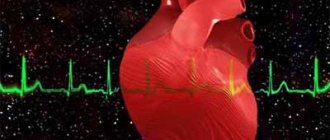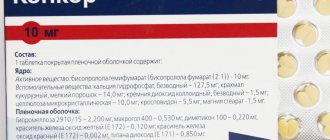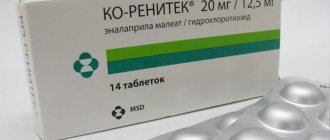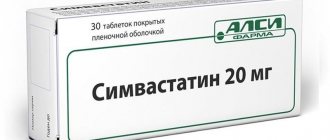The drug “Amprilan” belongs to the class of ACE inhibitors (angiotensin-converting enzyme), which dilate blood vessels and lower blood pressure. The drug is recommended for hypertension and heart failure, as well as for prophylactic use in patients who have suffered a heart attack, in order to reduce the risk of mortality and complications.
“Amprilan”: instructions for use, at what pressure and how exactly to take the drug, its use for certain indications, nature of action and characteristics of metabolism.
Compound
The active component of the tablets is ramipril. The drug is available in different dosages of ramipril per tablet: 1.25, 2.5, 5 and 10 mg.
The composition of fillers and excipients in the drug varies depending on the dosage of the active component, since according to the manufacturer’s plans, tablets with different dosages should have different colors.
Important! Tablets of any strength include lactose monohydrate, pregelatinized starch and sodium compounds (croscarmellose, bicarbonate and stearyl fumarate). Due to the lactose content, the drug is contraindicated in patients with lactose intolerance.
Tablets with a dosage of 5 mg, in addition to all the indicated substances, also contain a mix of dyes “RV 24899 pink”, and 2.5 mg - “RV 24886 yellow”. The remaining dosages do not contain dyes, are white in color and differ in size (the smallest and the largest).
The drug “Amprilan” in tablets of 10 mg
How to take Amprilan for kidney pathologies
The tablets are for oral administration only. They do not need to be crushed or chewed. The initial dose for various kidney pathologies is 1.25 mg once a day. If this dose does not give the desired therapeutic effect, it can be increased to 5 mg. But in the presence of chronic kidney pathologies, the recommended dose should not exceed 2.5 mg of the substance per day. With this treatment, you cannot additionally prescribe diuretics, as this will contribute to the rapid leaching of beneficial substances from the body.
The initial dose for various kidney pathologies is 1.25 mg once a day.
Release form
The drug is available only in tablet form. The tablets are packaged in blisters of 7 or 10 pieces. The blisters, together with the attached instructions for use, are placed in a cardboard box.
The tablets have an oblong shape, a flat surface and are chamfered. Tablets with a dosage of 1.25 mg and 10 mg have the natural color of the ingredients (close to white), differing only in size. 2.5 mg tablets are light yellow in color, 5 mg tablets are pink with lighter inclusions.
“Amprilan ND” (active ingredients: 5 mg ramipril and 25 mg hydrochlorothiazide)
Instructions for use and dosage
Instructions for use of Amprilan recommend drinking the tablets whole with water. The duration of the therapeutic course is determined individually. The optimal dosage of the drug also depends on the diagnosis and health status of the patient.
For hypertension, to normalize blood pressure, it is recommended to take 2.5 mg of the drug throughout the day. If there is no proper hypotensive effect, after 1-2 weeks of the treatment course, the daily dose is increased to 5 mg.
For patients suffering from cardiac diseases and nephropathy, Amprilan is prescribed at a starting dosage of 1.25 mg throughout the day. After 2 weeks of therapy, the dose of the drug is increased by 100% - to 2.5 mg, and then to 5 mg.
Patients who have suffered a myocardial infarction are recommended to use the drug at a dosage of 2.5 mg. With a sharp decrease in blood pressure, the daily dose of Amprilan is reduced to 1.25 mg and divided into two equal doses.
If the patient has been taking diuretic drugs, then before starting treatment with Amprilan they must be discontinued or the dosage reduced (at the doctor’s discretion).
Amprilan should be taken strictly as prescribed by your doctor.
Pharmacodynamics and pharmacokinetics
Ramipril is an angiotensin-converting enzyme inhibitor (ACEI), whose function is to accelerate the transformation of angiotensin I to angiotensin II. After the patient initially takes the drug, a decrease in blood pressure may already be registered after 2 hours (sometimes earlier). The maximum therapeutic effect is observed 4-6 hours after administration and lasts throughout the day. Taking the medication for 2-3 months reduces hypertrophy of the left cardiac ventricle, without any negative effect on the function of the organ.
The drug prevents the development of nephrotic diseases (including in patients with diabetes). It also has a strong effect in the treatment of heart failure. If signs of this disease are found in a patient who has had a heart attack, the use of the drug reduces the risk of mortality associated with diseases of the cardiovascular system. The listed positive effects are observed in patients both with and without signs of hypertension.
About 70% of the active component binds to plasma albumin. Regardless of whether the drug was taken with food or not, ramipril has very rapid absorption: within an hour after taking the tablets, its highest plasma concentration can be recorded. In the liver, it is broken down into metabolites - active (ramiprilat - its activity is 6 times higher than the activity of the original substance) and inactive (diketopiperazine).
The highest concentration of ramiprilat is recorded 3-4 hours after administration. A stable therapeutic concentration accumulates in the blood after 4 days of treatment. About 55% of the active metabolite is bound to plasma proteins.
Rampril and its active metabolite are excreted by the kidneys, with up to two percent of the former being excreted unchanged. Its half-life is just over 5 hours. For ramiprilat, its duration is up to 17 hours. Moreover, in patients with kidney disease, these indicators increase in proportion to the decrease in creatinine clearance. In patients with liver failure, laboratory tests show increased levels of unchanged ramipril in the blood. This is because deteriorating liver function affects its metabolic capacity.
A laboratory comparative study of the metabolic characteristics of ramipril in young and elderly healthy people did not reveal any significant differences.
Ramipril
Side effects
From the respiratory system:
- the appearance of a non-productive dry cough, worsening at night and in a lying position;
- bronchitis, sinusitis, less often – pharyngitis;
- dyspnea;
- bronchospasm.
From the nervous system:
- headaches, dizziness;
- feeling of weakness;
- occasionally patients experience depression;
- causeless anxiety, nervousness;
- motor restlessness, imbalance;
- sleep disorders;
- Very rarely, cerebral ischemia, paresthesia, and ischemic stroke occur.
From the cardiovascular system:
- excessive decrease in blood pressure, up to the development of collapse;
- feeling of heartbeat;
- peripheral edema;
- attacks of chest pain;
- in rare cases, infarction or myocardial ischemia, Raynaud's syndrome, and tachycardia occur.
From the genitourinary system, disorders occur rarely, among them are:
- decreased libido;
- increased diuresis;
- renal dysfunction;
- gynecomastia (extremely rare).
From the digestive system:
- inflammation of the mucous membrane of the gastrointestinal tract;
- feeling of discomfort in the epigastric region;
- dyspeptic symptoms;
- increased concentrations of liver enzymes and bilirubin in the blood;
- acute liver failure.
From the musculoskeletal system:
- convulsions;
- pain in muscles, joints.
From the senses:
- inflammation of the conjunctiva;
- visual disturbances;
- impairment of hearing, taste, smell.
In rare cases, patients may experience angioedema involving the mucous membrane of the eyes, lips, tongue, upper respiratory tract, hyperthermia and fever.
In the blood of patients using Amprilan tablets, the following is often found:
- increased potassium content;
- changes in the leukocyte formula (decrease in the number of neutrophils, platelets);
- increased activity of pancreatic enzymes;
- decreased number of red blood cells, hemolytic anemia;
- inhibition of bone marrow hematopoiesis.
Indications for use
The use of the drug is recommended for the following conditions:
- Hypertension;
- Nephropathy (including those caused by diabetes mellitus);
- Glomerulonephritis with increased protein content in the urine;
- Chronic heart failure;
- For patients who have suffered a stroke or myocardial infarction, as a means of maintenance therapy for general relief of the condition, reducing the likelihood of mortality and preventing the development of recurrent manifestations;
- In case of occlusive arterial circulation disorder;
- Patients who have undergone coronary artery bypass grafting or other surgical interventions on the arteries.
Hypertension
Contraindications
Contraindications to taking amipril are such conditions and diseases as:
- Renal failure (creatinine clearance value less than 20 ml/min);
- Stenosis of the aorta and heart valves, as well as stenosis of the renal arteries;
- Hypotensive conditions;
- Increased synthesis of aldosterones;
- A history of angioedema of any etiology;
- Inflammation of heart tissue;
- The presence of transplanted kidneys in the body;
- Hemodialysis;
- Lactose intolerance, galactose and high sensitivity to the active component of the drug;
- Therapy of nephropathy with immunomodulators, non-steroidal anti-inflammatory drugs, cytostatics, glucocorticoids;
- Minor age;
- Pregnancy (at any stage) and breastfeeding.
Caution should also be exercised when prescribing the drug to patients with the following pathologies:
- Angina;
- Systemic lupus erythematosus;
- Heart rhythm disturbances;
- Serious damage to the brain and heart arteries (as a decrease in blood pressure due to taking the drug can lead to a dangerously reduced blood supply to the heart or brain);
- Diabetes;
- Decompensated cor pulmonale;
- Conditions that accompany diarrhea and vomiting;
- Excess potassium and sodium deficiency in the body.
Blood pressure measurement process
Pharmacological properties of the drug Amprilan
Immediately after absorption in the liver, the active substance is metabolized into ramiprilat. Pharmacological properties allow ramipril to be classified as a long-acting ACE inhibitor.
Pharmacodynamics
Complete blockade of ACE receptors always helps to reduce the amount of angiotensin in the blood plasma. Renin activity, on the contrary, increases. The effect of bradykinin is enhanced, which leads to a significant increase in aldosterone synthesis. This can cause potassium levels in the blood to rise significantly.
The antihypertensive and hemodynamic effect of the drug is achieved by dilating blood vessels and reducing their resistance. This leads to a fairly rapid decrease in blood pressure. At the same time, the heart rhythm does not change in any way. Left ventricular hypertrophy also decreases. The hypotensive effect occurs within an hour after taking the tablet and can last a whole day. The medicine is often used to treat chronic heart failure.
Ramipril effectively reduces the incidence of acute myocardial infarction in patients with increased cardiogenic risk and diabetes mellitus. Moreover, this does not depend on blood pressure indicators.
The drug Amprilan lowers blood pressure.
Pharmacokinetics
After oral administration, the active substance is quickly absorbed from the gastrointestinal tract. The highest concentration in the blood is observed an hour after taking the tablet. Metabolism occurs in the liver. Bioavailability and ability to bind to protein structures is average. It is excreted from the body by the kidneys both in the form of metabolites and unchanged. With impaired renal function, excretion slows down depending on changes in creatinine clearance.
Side effects
Patients usually tolerate treatment with the drug, but the following side effects have been reported in clinical studies.
Frequent:
- Too much pressure reduction (especially if the patient is taking diuretics);
- Nausea, diarrhea, vomiting;
- Muscle pain and cramps;
- Inflammation of the mucous membranes of the gastrointestinal tract;
- Bronchitis and sinusitis;
- Skin rash;
- Dry cough;
- Migraine.
Rare:
- Peripheral cardiac edema;
- Heart rhythm disturbances;
- Joint pain;
- Dizziness;
- Increased fatigue, nervousness, anxiety;
- Insomnia;
- Kidney dysfunction;
- Increased protein and urea content in urine;
- Pancreatitis, jaundice, liver inflammation;
- Increased sweating.
Very rare:
- Myocardial infarction;
- Coronary heart disease and ischemic stroke;
- Tachycardia;
- Gynecomastia;
- Stomatitis;
- Baldness;
- Urticaria and dermatitis.
Migraine
The dosage of the drug is selected by the doctor taking into account the assessment of the general health profile of the patient and the condition of various body systems. It is permissible to take no more than 10 mg of the active substance per day. Tablets are taken without reference to meals. They are swallowed and washed down with at least 50 g of liquid. The duration of treatment is also prescribed by the doctor for each specific case.
Limitations on daily dosage:
- If the patient has kidney pathologies, you should not take more than 5 mg of the active ingredient per day;
- The same applies to patients with liver failure, only for them the maximum daily dose is already 2.5 mg per day;
- When creatinine clearance is less than 30 ml/min, the initial daily dose of the active substance should be 1.25 mg. Over time it is increased, but it should not exceed 5 mg;
- Taking the drug by pregnant women has a negative effect on the fetus, contributing to improper formation of the skull skeleton and underdevelopment of the lungs, therefore taking Amprilan is strictly contraindicated for pregnant women, and if a woman of childbearing age is prescribed to take the drug, she must first conduct a pregnancy test.
For high blood pressure, it is recommended to take 2.5 mg of ramipril once a day. In case of severe hypertension, if the condition of the body allows, the daily dose is increased to 5 mg one to two weeks after the start of treatment. If the patient is taking diuretics, their dose should be reduced 3 days before starting the drug (if possible, discontinued completely).
Heart patients are prescribed a dosage of 1.25 mg once daily. They, like the previous group of patients, need to stop diuretics (or reduce the dose) if they are taken. In the post-infarction state, 2.5 mg twice a day is first prescribed. If an excessive decrease in pressure is observed, the single dose is reduced to 1.25 mg (also taken twice a day). To prevent the development of heart failure after a heart attack, 2.5 mg tablets are prescribed: first, one tablet per day, after a week the dose is doubled, after a month it is doubled again - as maintenance therapy, the patient begins to receive 10 mg of the active substance per day.
For nephropathy of various etiologies, the patient starts with a dose of 1.25 mg per day. After two weeks it is doubled, then after two weeks of taking 2.5 mg per day it is doubled again. The patient stops at a maintenance dosage of 5 mg.
“Amprilan NL”
Amprilan
Use during pregnancy and breastfeeding
The drug Amprilan® is contraindicated for use during pregnancy, because
it may have adverse effects on the fetus (impaired renal function, hyperkalemia, hypoplasia of the skull bones, hypoplasia of the lungs). Therefore, before starting the use of Amprilan® in women of childbearing age, pregnancy should be excluded. If pregnancy is diagnosed, Amprilan® should be discontinued as soon as possible. If it is necessary to use the drug Amprilan® during lactation, breastfeeding should be discontinued.
Use for liver dysfunction
For liver failure, the initial recommended dose is 1.25 mg 1 time / day, the maximum daily dose is 2.5 mg.
Use for renal impairment
In patients with CC more than 0.5 ml/sec (30 ml/min), no dose change is required. For patients with CC less than 0.5 ml/sec (30 ml/min), an initial daily dose of 1.25 mg is recommended, and a maximum daily dose of 5 mg.
Use in children
Contraindication: age under 18 years (efficacy and safety have not been established).
Use in elderly patients
The drug should be prescribed with caution to elderly patients.
special instructions
At the beginning of treatment, renal function should be assessed. It is necessary to carefully monitor renal function in patients with impaired renal function, with heart failure, bilateral renal artery stenosis or stenosis of the artery of a solitary kidney, as well as in patients after kidney transplantation.
Liver failure
In rare cases, during the use of ACE inhibitors, cholestatic jaundice occurs, with the progression of which fulminant liver necrosis develops, sometimes with a fatal outcome. If jaundice or a significant increase in the activity of hepatic transaminases occurs while taking ACE inhibitors, the use of Amprilan® should be discontinued.
In patients with uncomplicated arterial hypertension, symptomatic arterial hypotension rarely develops after taking the first dose of the drug. The risk of developing arterial hypotension is increased in the following patients:
- patients with severe chronic heart failure: treatment begins with the lowest possible dose of Amprilan® (1.25 mg);
- patients taking diuretics: if possible, it is necessary to cancel the diuretic in advance or reduce its dose; treatment begins with a minimum dose of Amprilan® (1.25 mg);
- patients who may develop hypovolemia due to insufficient fluid intake, diarrhea, vomiting, or excessive sweating in conditions of insufficient compensation for salt and fluid loss. It is usually recommended to adjust the blood volume before starting treatment, but if these conditions become clinically significant, treatment with Amprilan® can be started and/or continued with a minimum dose (1.25 mg) and under medical supervision.
Aortic stenosis/Mitral stenosis/Hypertrophic cardiomyopathy
ACE inhibitors should be used with caution in patients with left ventricular outflow tract obstruction and aortic and/or mitral stenosis.
Neutropenia/Agranulocytosis
In patients taking ACE inhibitors, cases of neutropenia/agranulocytosis, thrombocytopenia and anemia may develop. In patients with normal renal function in the absence of other complications, neutropenia rarely develops and resolves spontaneously after discontinuation of ACE inhibitors.
Ramipril should be used with great caution in patients with connective tissue diseases and simultaneously receiving immunosuppressive therapy, allopurinol or procainamide, especially with existing renal impairment. These patients may develop severe infections that do not respond to intensive antibiotic therapy. When using ramipril, it is recommended to periodically monitor the number of leukocytes in the blood. The patient should be warned that if any signs of an infectious disease appear (sore throat, fever), consult a doctor immediately.
Hyperkalemia
May develop during treatment with ACE inhibitors, incl. and ramipril. Risk factors for hyperkalemia are renal failure, old age, diabetes mellitus, some concomitant conditions (decrease in blood volume, acute heart failure in the stage of decompensation, metabolic acidosis), simultaneous use of potassium-sparing diuretics (such as spironolactone, eplerenone, triamterene, amiloride), as well as drugs potassium or potassium-containing substitutes for table salt and the use of other drugs that increase the content of potassium in the blood plasma (for example, heparin). Hyperkalemia can cause serious heart rhythm problems, sometimes fatal.
Potassium-sparing diuretics and potassium supplements
The combined use of Amprilan® and potassium-sparing diuretics, as well as potassium preparations and potassium-containing table salt substitutes is not recommended.
Surgical interventions/General anesthesia
The use of ACE inhibitors in patients undergoing surgery under general anesthesia can lead to a significant decrease in blood pressure, especially when using general anesthesia agents that have a hypotensive effect.
It is recommended to stop taking ACE inhibitors, incl. ramipril, 12 hours before surgery, warning the anesthesiologist about the use of ACE inhibitors.
Cough
During therapy with an ACE inhibitor, a dry cough may occur, which disappears after discontinuation of drugs in this group. If a dry cough appears, you should be aware of the possible connection of this symptom with taking an ACE inhibitor.
Anaphylactoid reactions during desensitization procedures
There are isolated reports of the development of long-term, life-threatening anaphylactoid reactions in patients receiving ACE inhibitors during desensitizing therapy with the venom of hymenoptera insects (bees, wasps). ACE inhibitors should be used with caution in patients prone to allergic reactions undergoing desensitization procedures. Prescription of an ACE inhibitor should be avoided in patients receiving immunotherapy with hymenoptera venom. However, the development of anaphylactoid reactions can be avoided by temporarily discontinuing the ACE inhibitor at least 24 hours before the start of the desensitization procedure.
Anaphylactoid reactions during LDL apheresis
In rare cases, life-threatening anaphylactoid reactions may occur in patients receiving ACE inhibitors during LDL apheresis using dextran sulfate. To prevent an anaphylactoid reaction, ACE inhibitor therapy should be discontinued before each LDL apheresis procedure using high-flux membranes.
Hemodialysis
Anaphylactoid reactions have been reported in patients receiving ACE inhibitors during hemodialysis using high-flux membranes (eg, AN69®). Therefore, it is advisable to use a different type of membrane or use an antihypertensive drug of a different pharmacotherapeutic group.
Impact on the ability to drive vehicles and operate machinery
During the treatment period, care must be taken when engaging in potentially hazardous activities that require increased concentration and speed of psychomotor reactions, because Dizziness, drowsiness, confusion and other side effects are possible.
Overdose
Signs of a drug overdose:
- Slowing heartbeat;
- Severe drop in blood pressure;
- Problems with water and electrolyte balance (excess potassium, lack of sodium);
- Phenomena of renal failure;
- Shock.
If a pronounced drop in pressure is observed, the patient is placed on his back (there should be no pillow under the head) and catecholamines, dopamine, and angiotensinamide are administered intravenously. If your heart rate is very low, you can consider implanting a pacemaker.
To relieve the consequences of an overdose, it is advisable to perform a gastric lavage on the victim as soon as possible (within half an hour after taking a disproportionately high dose of the drug) and take a sorbent (enterosgel, activated carbon). The administration of sodium sulfate is indicated. There are no clinical data on the effectiveness of hemodialysis.
Patients taking ramipril need to monitor their kidney function, the concentration of potassium ions in the blood and blood pressure.
Interaction
ACE inhibitors, including ramipril, increase the depressant effect of alcohol on the nervous system. Drinking alcohol while taking the drug puts a significant burden on the liver, so when treating with this drug, the use of products containing ethanol should be avoided.
Concomitant use of ATP inhibitors and non-steroidal anti-inflammatory drugs worsens renal function and may contribute to the development of acute renal failure.
Drugs based on epinephrine neutralize the ability of Amprilan to reduce blood pressure.
Tricyclic antidepressants, on the contrary, enhance the hypotensive effect of the drug.
When ramipril was used with lithium-based drugs, a strong increase in plasma lithium levels was observed, approaching concentrations that have a toxic effect.
A number of drugs, when taken together with ramipril, can contribute to the development of leukopenia. These include:
- Cytostatics;
- Procainamide;
- Immunosuppressants;
- Allopurinol;
- Glucocorticoids.
Analogs
Analogs of the drug are medications with the same active ingredient, for example:
- “Pyramid”;
- “Hartil”;
- “Dilaprel”;
- "Vazolong".
Dilaprel
The use of Amprilan (in the absence of contraindications) is advisable for hypertensive conditions, as well as for the prevention and relief of heart failure, including those that develop after a heart attack and stroke. However, the drug imposes a very large number of restrictions on use. Only the attending physician should prescribe the regimen and dosage.











